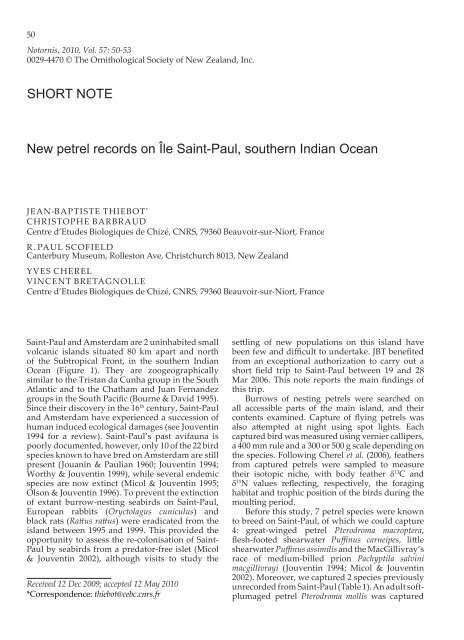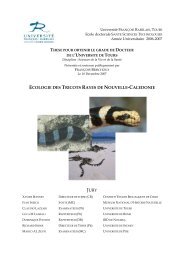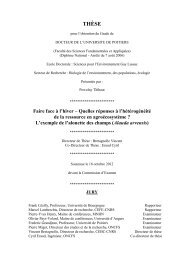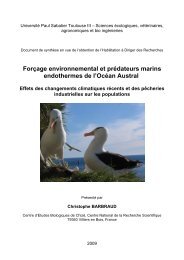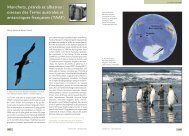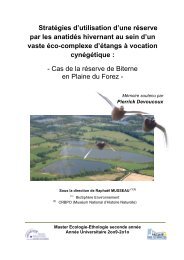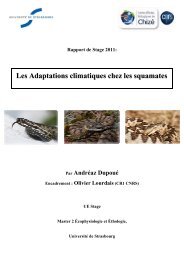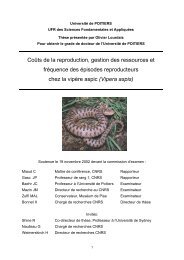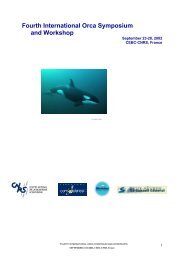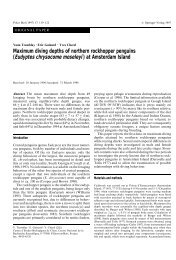SHORT NOTE New petrel records on Île Saint-Paul, southern Indian ...
SHORT NOTE New petrel records on Île Saint-Paul, southern Indian ...
SHORT NOTE New petrel records on Île Saint-Paul, southern Indian ...
Create successful ePaper yourself
Turn your PDF publications into a flip-book with our unique Google optimized e-Paper software.
50<br />
Notornis, 2010, Vol. 57: 50-53<br />
0029-4470 © The Ornithological Society of <str<strong>on</strong>g>New</str<strong>on</strong>g> Zealand, Inc.<br />
<str<strong>on</strong>g>SHORT</str<strong>on</strong>g> <str<strong>on</strong>g>NOTE</str<strong>on</strong>g><br />
<str<strong>on</strong>g>New</str<strong>on</strong>g> <str<strong>on</strong>g>petrel</str<strong>on</strong>g> <str<strong>on</strong>g>records</str<strong>on</strong>g> <strong>on</strong> <strong>Île</strong> <strong>Saint</strong>-<strong>Paul</strong>, <strong>southern</strong> <strong>Indian</strong> Ocean<br />
JEAN-BAPTISTE ThIEBOT *<br />
ChrISTOPhE BArBrAuD<br />
Centre d’Etudes Biologiques de Chizé, CNrS, 79360 Beauvoir-sur-Niort, France<br />
r. PAul SCOFIElD<br />
Canterbury Museum, rollest<strong>on</strong> Ave, Christchurch 8013, <str<strong>on</strong>g>New</str<strong>on</strong>g> Zealand<br />
YvES ChErEl<br />
vINCENT BrETAGNOllE<br />
Centre d’Etudes Biologiques de Chizé, CNrS, 79360 Beauvoir-sur-Niort, France<br />
<strong>Saint</strong>-<strong>Paul</strong> and Amsterdam are 2 uninhabited small<br />
volcanic islands situated 80 km apart and north<br />
of the Subtropical Fr<strong>on</strong>t, in the <strong>southern</strong> <strong>Indian</strong><br />
Ocean (Figure 1). They are zoogeographically<br />
similar to the Tristan da Cunha group in the South<br />
Atlantic and to the Chatham and Juan Fernandez<br />
groups in the South Pacific (Bourne & David 1995).<br />
Since their discovery in the 16 th century, <strong>Saint</strong>-<strong>Paul</strong><br />
and Amsterdam have experienced a successi<strong>on</strong> of<br />
human induced ecological damages (see Jouventin<br />
1994 for a review). <strong>Saint</strong>-<strong>Paul</strong>’s past avifauna is<br />
poorly documented, however, <strong>on</strong>ly 10 of the 22 bird<br />
species known to have bred <strong>on</strong> Amsterdam are still<br />
present (Jouanin & <strong>Paul</strong>ian 1960; Jouventin 1994;<br />
Worthy & Jouventin 1999), while several endemic<br />
species are now extinct (Micol & Jouventin 1995;<br />
Ols<strong>on</strong> & Jouventin 1996). To prevent the extincti<strong>on</strong><br />
of extant burrow-nesting seabirds <strong>on</strong> <strong>Saint</strong>-<strong>Paul</strong>,<br />
European rabbits (Oryctolagus cuniculus) and<br />
black rats (Rattus rattus) were eradicated from the<br />
island between 1995 and 1999. This provided the<br />
opportunity to assess the re-col<strong>on</strong>isati<strong>on</strong> of <strong>Saint</strong>-<br />
<strong>Paul</strong> by seabirds from a predator-free islet (Micol<br />
& Jouventin 2002), although visits to study the<br />
Received 12 Dec 2009; accepted 12 May 2010<br />
*Corresp<strong>on</strong>dence: thiebot@cebc.cnrs.fr<br />
settling of new populati<strong>on</strong>s <strong>on</strong> this island have<br />
been few and difficult to undertake. JBT benefited<br />
from an excepti<strong>on</strong>al authorizati<strong>on</strong> to carry out a<br />
short field trip to <strong>Saint</strong>-<strong>Paul</strong> between 19 and 28<br />
Mar 2006. This note reports the main findings of<br />
this trip.<br />
Burrows of nesting <str<strong>on</strong>g>petrel</str<strong>on</strong>g>s were searched <strong>on</strong><br />
all accessible parts of the main island, and their<br />
c<strong>on</strong>tents examined. Capture of flying <str<strong>on</strong>g>petrel</str<strong>on</strong>g>s was<br />
also attempted at night using spot lights. Each<br />
captured bird was measured using vernier callipers,<br />
a 400 mm rule and a 300 or 500 g scale depending <strong>on</strong><br />
the species. Following Cherel et al. (2006), feathers<br />
from captured <str<strong>on</strong>g>petrel</str<strong>on</strong>g>s were sampled to measure<br />
their isotopic niche, with body feather δ 13 C and<br />
δ 15 N values reflecting, respectively, the foraging<br />
habitat and trophic positi<strong>on</strong> of the birds during the<br />
moulting period.<br />
Before this study, 7 <str<strong>on</strong>g>petrel</str<strong>on</strong>g> species were known<br />
to breed <strong>on</strong> <strong>Saint</strong>-<strong>Paul</strong>, of which we could capture<br />
4: great-winged <str<strong>on</strong>g>petrel</str<strong>on</strong>g> Pterodroma macroptera,<br />
flesh-footed shearwater Puffinus carneipes, little<br />
shearwater Puffinus assimilis and the MacGillivray’s<br />
race of medium-billed pri<strong>on</strong> Pachyptila salvini<br />
macgillivrayi (Jouventin 1994; Micol & Jouventin<br />
2002). Moreover, we captured 2 species previously<br />
unrecorded from <strong>Saint</strong>-<strong>Paul</strong> (Table 1). An adult softplumaged<br />
<str<strong>on</strong>g>petrel</str<strong>on</strong>g> Pterodroma mollis was captured
Fig. 1. Map of <strong>Île</strong> <strong>Saint</strong>-<strong>Paul</strong><br />
showing where <str<strong>on</strong>g>petrel</str<strong>on</strong>g>s were<br />
captured: Cookilaria <str<strong>on</strong>g>petrel</str<strong>on</strong>g><br />
(solid star), soft-plumaged<br />
<str<strong>on</strong>g>petrel</str<strong>on</strong>g> (open star), greatwinged<br />
<str<strong>on</strong>g>petrel</str<strong>on</strong>g> (solid circle),<br />
flesh-footed shearwater<br />
(solid triangle), little shearwater<br />
(open triangle) and<br />
MacGillivray’s pri<strong>on</strong> (open<br />
circle).<br />
using spot-lighting at the top of a sea cliff <strong>on</strong> 23<br />
Mar, after calls of this species were heard. This is<br />
the 1st c<strong>on</strong>firmed record of this species <strong>on</strong> <strong>Saint</strong>-<br />
<strong>Paul</strong>, although Bourne & David (1995) menti<strong>on</strong>ed<br />
it may have formerly bred <strong>on</strong> the island. P. mollis<br />
is known to persist <strong>on</strong> Amsterdam (Jouventin<br />
1994; Bretagnolle 1995), but suffers predati<strong>on</strong> by<br />
rats and cats <strong>on</strong> adults, eggs and nestlings there<br />
(Jouventin 1994). A smaller Pterodroma <str<strong>on</strong>g>petrel</str<strong>on</strong>g> was<br />
captured <strong>on</strong> the night of 26 Mar while it was sitting<br />
<strong>on</strong> a Scirpus nodosus sedge at the top of another sea<br />
cliff. Its general appearance (Figures 2a, 2b & 2c)<br />
suggested it bel<strong>on</strong>ged to the Cookilaria subgenus<br />
(sensu Fleming 1941), a subgenus that has not<br />
been observed <strong>on</strong> <strong>Saint</strong>-<strong>Paul</strong> nor Amsterdam. The<br />
combinati<strong>on</strong> of (1) a short and stout bill, (2) a broad<br />
black margin to the leading edge of the under-<br />
Table 1. Measurements and feather isotopic ratios (δ 13 C<br />
and δ 15 N) of the soft-plumaged and the Cookilaria <str<strong>on</strong>g>petrel</str<strong>on</strong>g>s<br />
captured <strong>on</strong> <strong>Saint</strong>-<strong>Paul</strong>.<br />
Softplumaged<br />
<str<strong>on</strong>g>petrel</str<strong>on</strong>g><br />
Cookilaria<br />
<str<strong>on</strong>g>petrel</str<strong>on</strong>g><br />
Culmen length (mm) 29.9 23.4<br />
hook height (mm) 11.5 8.6<br />
Tarsus length (mm) 35.3 31.3<br />
Wing length (mm) 259 232<br />
Body mass (g) 315 165<br />
δ 13 C (‰) -16.5 -17.7<br />
δ 15 N (‰) 15.0 12.1<br />
Short note<br />
51<br />
wing, together with (3) flesh-coloured feet with<br />
black terminal areas excluded Cook’s (Pterodroma<br />
cookii), De Filippi’s (P. defilippiana) and Pycroft’s (P.<br />
pycrofti) <str<strong>on</strong>g>petrel</str<strong>on</strong>g>s, whereas the underwing, belly and<br />
back colourati<strong>on</strong>s excluded Chatham (P. axillaris),<br />
B<strong>on</strong>in (P. hypoleuca), mottled (P. inexpectata), and<br />
Gould’s (P. leucoptera) <str<strong>on</strong>g>petrel</str<strong>on</strong>g>s. Based <strong>on</strong> plumage<br />
colourati<strong>on</strong>, this bird was therefore most probably<br />
a black-winged <str<strong>on</strong>g>petrel</str<strong>on</strong>g> (P. nigripennis), and its<br />
measurements fall within the known range for<br />
this species (Marchant & higgins 1990). The fresh<br />
plumage, with unworn primaries, clean uncut bill<br />
and the l<strong>on</strong>g, sharp and unscratched claws suggest<br />
that this individual was sub-adult. No vocalisati<strong>on</strong><br />
was uttered by the bird before its capture or during<br />
handling.<br />
The black-winged <str<strong>on</strong>g>petrel</str<strong>on</strong>g> breeds at numerous<br />
islands in the south-west Pacific Ocean (Jenkins<br />
& Cheshire 1982; Marchant & higgins 1990). It<br />
has rapidly expanded its breeding range during<br />
the last 50 years (Klapste 1981; Powlesland 1985)<br />
and 2 pairs recently were found in burrows <strong>on</strong><br />
round I, Mauritius in the <strong>Indian</strong> Ocean (Birdlife<br />
Internati<strong>on</strong>al 2009). The bird found <strong>on</strong> <strong>Saint</strong>-<strong>Paul</strong><br />
further c<strong>on</strong>firms the col<strong>on</strong>isati<strong>on</strong> of seabirds from<br />
the Pacific regi<strong>on</strong> that <strong>Saint</strong>-<strong>Paul</strong> has experienced<br />
in recent decades (see Seg<strong>on</strong>zac 1972; lequette et al.<br />
1995). It is unlikely, however, that the bird captured<br />
was a fledgling of the year from the Pacific col<strong>on</strong>ies,<br />
as these populati<strong>on</strong>s fledge later, in early May<br />
(hutt<strong>on</strong> & Priddel 2002). Interestingly, Worthy &<br />
Jouventin (1996) indicated the former presence of 2<br />
endemic Pterodroma species <strong>on</strong> Amsterdam (Jouanin<br />
& <strong>Paul</strong>ian 1960) based <strong>on</strong> sub-fossil remains, and<br />
the smaller tax<strong>on</strong> was estimated to be the size of
52<br />
Short note<br />
P. nigripennis. until recently, both endemic species<br />
were c<strong>on</strong>sidered extinct (Jouventin 1994; Micol &<br />
Jouventin 1995), but our record suggests that the<br />
smaller <strong>on</strong>e might actually still exist <strong>on</strong> <strong>Saint</strong>-<strong>Paul</strong>,<br />
as a putative P. nigripennis with an earlier breeding<br />
seas<strong>on</strong>. Genetic analysis is needed to c<strong>on</strong>firm this<br />
suspici<strong>on</strong>. Such a populati<strong>on</strong> could have been<br />
overlooked for 2 centuries as <strong>Saint</strong>-<strong>Paul</strong> has not<br />
been prospected exhaustively, nor have there been<br />
extensive surveys <strong>on</strong> all of its predator-free islets<br />
(Tollu 1984; Micol & Jouventin 1995). On inhabited<br />
lord howe I (south-west Pacific Ocean), sub-fossil<br />
b<strong>on</strong>es similarly revealed the presence in the past of<br />
P. nigripennis, though early accounts by naturalists<br />
did not menti<strong>on</strong> it until 1971 (hindwood 1940;<br />
Fullagar et al. 1974).<br />
To our knowledge, our results are the 1st to<br />
document the isotopic niche of P. nigripennis and<br />
P. mollis, thus precluding comparis<strong>on</strong> between<br />
the <strong>Saint</strong>-<strong>Paul</strong> specimens with birds from known<br />
breeding col<strong>on</strong>ies. The isotopic niche of the putative<br />
P. nigripennis from <strong>Saint</strong>-<strong>Paul</strong> suggests that it<br />
moulted in subtropical waters or was fed as a large<br />
chick from adults foraging in this area, as its δ 13 C<br />
value was different from the carb<strong>on</strong> signature of<br />
birds moulting in the Southern Ocean (Cherel et al.<br />
2006), but it was identical to that of chicks of <strong>Indian</strong><br />
yellow-nosed albatross (Thalassarche carteri) from<br />
Amsterdam (Jaeger et al. 2009), whose parents are<br />
known to forage in the subtropics (Pinaud et al.<br />
2005). Its δ 15 N value indicates that the bird had a<br />
lower trophic positi<strong>on</strong> than T. carteri, as would be<br />
expected from its much smaller size. The δ 13 C value<br />
of the <strong>Saint</strong>-<strong>Paul</strong> P. mollis is close to that of adults<br />
of T. carteri from Amsterdam (YC, unpubl. data),<br />
suggesting that the bird moulted offshore Australia,<br />
as do adults of T. carteri from Amsterdam (rolland<br />
et al. 2009).<br />
Another survey is needed, earlier in the<br />
seas<strong>on</strong>, to evaluate the breeding status of<br />
Pterodroma <str<strong>on</strong>g>petrel</str<strong>on</strong>g>s <strong>on</strong> <strong>Saint</strong>-<strong>Paul</strong> and to obtain<br />
blood samples to c<strong>on</strong>firm the identity of the<br />
putative P. nigripennis. An investigati<strong>on</strong> of the<br />
westward expansi<strong>on</strong> of P. nigripennis <strong>on</strong> the<br />
<strong>Indian</strong> Ocean islands would also help clarify our<br />
Cookilaria record. Finally, our results suggest the<br />
need to start m<strong>on</strong>itoring burrow-nesting seabirds<br />
<strong>on</strong> <strong>Île</strong> Amsterdam, where feral cattle eradicati<strong>on</strong><br />
is currently underway.<br />
AcknowledgemenTs<br />
JBT is grateful to the Captain and crew of ‘l’Austral’<br />
fishing vessel, to the members of the 57 th missi<strong>on</strong> <strong>on</strong><br />
Amsterdam Island for help <strong>on</strong> the field, to Audrey Jaeger<br />
for stable isotope analyses, and to Matthieu Authier for<br />
comments <strong>on</strong> the manuscript. This study was supported<br />
by IPEv (program 109, directed by h. Weimerskirch) and<br />
the administrati<strong>on</strong> of TAAF.<br />
A<br />
Fig. 2. views (A, B, c) of the Cookilaria <str<strong>on</strong>g>petrel</str<strong>on</strong>g> captured<br />
<strong>on</strong> <strong>Saint</strong>-<strong>Paul</strong> <strong>on</strong> 26 Mar 2006 (all photographs by JB<br />
Thiebot).<br />
liTerATure ciTed<br />
Birdlife Internati<strong>on</strong>al 2009. Important Bird Area<br />
factsheet: round Island, Mauritius. http://www.<br />
birdlife.org.<br />
Bourne, W.r.P.; David, A.C.F. 1995. The early history and<br />
ornithology of <strong>Saint</strong>-<strong>Paul</strong> and Amsterdam Islands,<br />
<strong>southern</strong> <strong>Indian</strong> Ocean. Le Gerfaut 85: 19–36.<br />
B<br />
C
Bretagnolle, v. 1995. Systematics of the soft-plumaged<br />
<str<strong>on</strong>g>petrel</str<strong>on</strong>g> Pterodroma mollis complex: new insight from<br />
vocalizati<strong>on</strong>s. Ibis 137: 207–218.<br />
Cherel, Y.; Phillips, r.A.; hobs<strong>on</strong>, K.A.; McGill, r. 2006.<br />
Stable isotope evidence of diverse species-specific and<br />
individual wintering strategies in seabirds. Biology<br />
Letters 2: 301–303.<br />
Fleming, C.A. 1941. Notes <strong>on</strong> Neozelanic forms of the<br />
subgenus Cookilaria. Emu 41: 69–80.<br />
Fullagar, P.J.; McKean, J.l.; van Tets, G.F. 1974. Appendix<br />
F. report <strong>on</strong> the birds. pp. 55–72 In: recher, h.F.; Clark,<br />
S.S. (eds.) Envir<strong>on</strong>mental Survey of Lord Howe Island.<br />
Sydney: <str<strong>on</strong>g>New</str<strong>on</strong>g> South Wales Government Printer.<br />
hindwood, K.A. 1940. The birds of lord howe Island.<br />
Emu 40: 1–86.<br />
hutt<strong>on</strong>, I.; Priddel, D. 2002. Breeding biology of the blackwinged<br />
<str<strong>on</strong>g>petrel</str<strong>on</strong>g>, Pterodroma nigripennis, <strong>on</strong> lord howe<br />
Island. Emu 102: 361–365.<br />
Jaeger, A.; Blanchard, P.; richard, P.; Cherel, Y. 2009.<br />
using carb<strong>on</strong> and nitrogen isotopic values of body<br />
feathers to infer inter- and intra-individual variati<strong>on</strong>s<br />
of seabird feeding ecology during moult. Marine<br />
Biology 156: 1233–1240.<br />
Jenkins, J.A.F.; Cheshire, N.G. 1982. The black-winged<br />
<str<strong>on</strong>g>petrel</str<strong>on</strong>g> (Pterodroma nigripennis) in the south-west Pacific<br />
and the Tasman Sea. Notornis 29: 293–310.<br />
Jouanin, C. ; <strong>Paul</strong>ian, P. 1960. recherches sur des ossements<br />
d’oiseaux provenant de l’Ile Nouvelle-Amsterdam<br />
(Ocean Indien). Proceedings of the XII Internati<strong>on</strong>al<br />
Ornithological C<strong>on</strong>gress, Helsinki 1: 368–372.<br />
Jouventin, P. 1994. Past, present and future of Amsterdam<br />
Island, <strong>Indian</strong> Ocean. pp. 122–132 In: Nettleship, D.N.;<br />
Burger, J.; Gochfeld, M. (eds.) Seabirds <strong>on</strong> islands: threats,<br />
case studies and acti<strong>on</strong> plans. Cambridge: Birdlife<br />
Internati<strong>on</strong>al.<br />
Klapste, J. 1981. Notes <strong>on</strong> the black-winged <str<strong>on</strong>g>petrel</str<strong>on</strong>g> Pterodroma<br />
nigripennis. Australian Bird Watcher 9: 35–40.<br />
lequette, B.; Berteaux, D.; Judas, J. 1995. Presence and first<br />
breeding attempts of <strong>southern</strong> gannets Morus capensis<br />
and M. serrator at <strong>Saint</strong>-<strong>Paul</strong> Island, <strong>southern</strong> <strong>Indian</strong><br />
Ocean. Emu 95: 134–137.<br />
Short note<br />
53<br />
Marchant, S.; higgins, P.J. 1990. Handbook of Australian,<br />
<str<strong>on</strong>g>New</str<strong>on</strong>g> Zealand and Antarctic birds - Volume 1. Ratites to<br />
ducks. Melbourne: Oxford university Press.<br />
Micol, T.; Jouventin, P. 1995. restorati<strong>on</strong> of Amsterdam<br />
Island, south <strong>Indian</strong> Ocean, following c<strong>on</strong>trol of feral<br />
cattle. Biological C<strong>on</strong>servati<strong>on</strong> 73: 199–206.<br />
Micol, T.; Jouventin, P. 2002. Eradicati<strong>on</strong> of rats and rabbits<br />
from <strong>Saint</strong>-<strong>Paul</strong> Island, French Southern territories.<br />
pp. 199–205 In: veitch, C.r.; Clout, M.N. (eds.) Turning<br />
the tide: the eradicati<strong>on</strong> of invasive species. Gland and<br />
Cambridge: IuCN.<br />
Ols<strong>on</strong>, S.l.; Jouventin, P. 1996. A new species of small<br />
flightless duck from Amsterdam Island, <strong>southern</strong><br />
<strong>Indian</strong> Ocean (Anatidae: Anas marecula). C<strong>on</strong>dor 98:<br />
1–9.<br />
Pinaud, D.; Cherel, Y.; Weimerskirch, h. 2005. Effect of<br />
envir<strong>on</strong>mental variability <strong>on</strong> habitat selecti<strong>on</strong>, diet,<br />
provisi<strong>on</strong>ing behaviour and chick growth in yellownosed<br />
albatrosses. Marine Ecology Progress Series 298:<br />
295–304.<br />
Powlesland, r.G. 1985. Seabirds found dead <strong>on</strong> <str<strong>on</strong>g>New</str<strong>on</strong>g><br />
Zealand beaches in 1983 and a review of albatross<br />
recoveries since 1960. Notornis 32: 23–41.<br />
rolland, v.; Barbraud, C.; Weimerskirch, h. 2009.<br />
Assessing the impact of fisheries, climate and disease<br />
<strong>on</strong> the dynamics of the <strong>Indian</strong> yellow-nosed Albatross.<br />
Biological C<strong>on</strong>servati<strong>on</strong> 142: 1084–1095.<br />
Seg<strong>on</strong>zac, M. 1972. D<strong>on</strong>nées récentes sur la faune des<br />
îles <strong>Saint</strong>-<strong>Paul</strong> et Nouvelle-Amsterdam. L’Oiseau et la<br />
Revue Française d’Ornithologie 42: 3–65.<br />
Tollu, B. 1984. la Quille (île <strong>Saint</strong>-<strong>Paul</strong>, océan Indien),<br />
sanctuaire de populati<strong>on</strong>s relictes. L’Oiseau et la Revue<br />
Française d’Ornithologie 54: 79–85.<br />
Worthy, T.h.; Jouventin, P. 1999. The fossil Avifauna<br />
of Amsterdam Island, <strong>Indian</strong> Ocean. Smiths<strong>on</strong>ian<br />
C<strong>on</strong>tributi<strong>on</strong>s to Paleobiology 89: 39–65.<br />
keywords <strong>Île</strong>s <strong>Saint</strong>-<strong>Paul</strong> and Amsterdam; <strong>southern</strong><br />
<strong>Indian</strong> ocean; seabirds; re-col<strong>on</strong>isati<strong>on</strong>; Procellariiformes;<br />
fossil avifauna; isotopic niche


